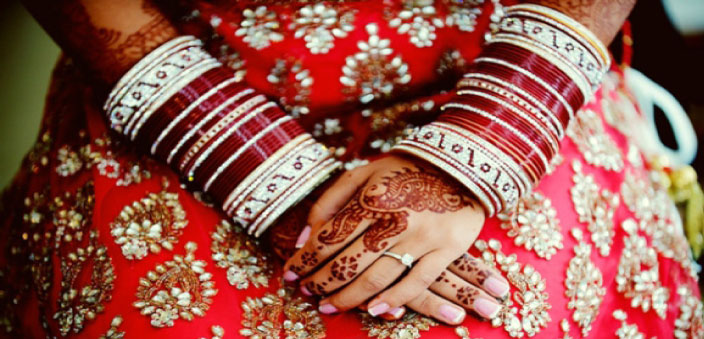AMere haathon mein nau nau choodiyan hai is only one of the many refrains picked from songs in Hindi films that are very popular among the masses. Another famous number is Bindiya chamkegi, choodi khankegi from another film. Bangles (choodiyan) are an integral part of the Indian woman’s wear, especially after she gets married. Bangles are traditionally a part of the solah shringar of Indian brides. It is mandatory for newly wed brides and would-be-brides to wear bangles made of glass, gold or other metals, as they signify the long life of the husband. They signify good fortune and prosperity. Traditionally, breaking of the bridal glass or lac bangles was once considered inauspicious. Different coloured bangles traditionally signify different things. Red signifies energy and prosperity, while green denotes good luck and fertility. Yellow bangles are meant for happiness, white is for new beginnings and orange is for success. Silver bangles denote strength and gold bangles are the ultimate symbol of fortune and prosperity.
The unique shankha-paula bangle
Among the several varieties of bangles worn by married women of different regional cultures, a rare presence is defined by the shankha and paula worn by married women in Bengal. It is now infra dig for young women, married or not, to sport these two bangles with any kind of wear – Western or Indian or any other. It originated in what is now Bangladesh. Few people however, including Bengali women who wear it, know about the history and origins of the shankha and the paula.
The beautiful sound of the conch shell blowing rhythmically in a Bengali home infuses the mood of a beautiful celebration of life – the wedding of two souls bound in matrimony for all time to come. The conch shell is considered auspicious among the Hindu community in India. The general whiteness of the conch shell – though it is also in off-white and patterned streaks, is a symbol of purity. Banabhatt’s Kadambari mentions Goddess Saraswati wearing a thick bangle (kangan) crafted out of a conch shell.
White bangles crafted out of conch shells called the shankha, and red bangles made out of coral simply called paula, are mandatory marriage symbols for the Bengali wife which she first wears on the day of her marriage before nuptials and after a turmeric bath. A brief religious ceremony is traditionally performed on the morning of the wedding to welcome Goddess Shakti. In some families, the father or guardian of the bride gives her a pair of conch bangles during the chanting of wedding hymns. The groom also brings a pair for her. The bangle set the bride wears is called shankha-paula, comprising one bracelet in white conch shell and one in red.
A Bengali wife also traditionally wears a plain iron bangle next to the skin, usually on the left wrist, in order to protect her husband from the evil eye. Traditionally, a married woman avoids buying a second pair unless the existing ones break because the breaking of these bangles is said to be inauspicious and considered to be a bad omen. In case a bangle cracks or breaks, it must be replaced without the husband being aware of it. No wife is supposed to say, ‘my shankha broke’ or ‘my paula cracked.’ When a Bengali wife finds that a shankha or a paula bangle has cracked or has broken – they are very fragile – she uses euphemisms like ‘my shankha has increased’ or ‘my paula is jingling.’ The same euphemism is used when the stock of rice in the family larder is finished. The parallel drawn between the two points out the auspiciousness of rice and the red and white bangle on the one hand, and the nurturing qualities inherent in the wife who feeds the whole family, on the other. Rice is symbolic of Goddess Annapurna, “anna” meaning food or rice in Bengali and ‘poorna’ meaning ‘full of.’ The ideal Bengali wife is often compared to the Goddess Annapoorna, as a compliment. Hindu women, who are not well-off, nowadays, wear white, plastic bangles, which look like shankhas, as they cannot afford the real shankhas.
The paula is traditionally, a plain gold bangle without designs except for gold ornamentations. But the shankha is purely a work of art practiced by skilled and creative artisans who go under the professional umbrella of ‘shankharis’ – craftsmen specialising in making artifacts out of conch shells with the shankha commanding the highest demand. Conch bangles or shankhas are decorated with about 25 types of engravings.
Lotus bud, lily petal, buds of wild flowers, sheaf of paddy and shape of jasmine are among the common designs. The joints of the bangles are neatly done and covered with engravings to make them invisible.
Habiba Khatun, who has done considerable research on the famous shankhari-pada in Dhaka, Bangladesh, writes that designs of fish, Capricorn, butterfly, pitcher, chillum, lotus bud, paddy sheaf; leaf of marigold, parakeet and bamboo line are crafted on these bangles. The shankhas have names to identify the designs such as banshrekhi (bamboo-lined), karnishdar (arched), khayesha (desired), bachhadar (select), phultaranga (waving flower), diamond karya (diamond work), makarchehara (Capricorn face), rangeela (colored), Ram-Lakshman (holy brothers), paddy sheaf and padmakali (lotus bud). Families who cannot afford these very expensive shankhas usually buy the low-priced variety decorated with water flowers like the lily. If gold is used for lacings and decorations, the price will rise according to the quantity of gold used and the degree of craftsmanship that it demands. Handicrafts and jewels crafted out of the conch shell is an ancient cottage craft among Bengalis.
Though the modern Bengali bride dispenses with the shankha and the paula about a week after the wedding, she retains the loha mostly laced or decorated in gold. Bengali cinema, but for a few exceptions, has remained loyal to its screen depiction of the Bengali bride and the Bengali wife. She continues to sport the shankha and the paula along with the loha on the Bengali screen even when the film is made in Hindi. From Bimal Roy’s Devdas (1959) to Sanjay Leela Bhansali’s Devdas (2002), through Rituparno Ghosh’s Chokher Bali (2003), the Bengali bride is enriched and visually enhanced as the duet of the shankha and the paula embraces her graceful wrists.
Dhaka was once renowned for shankha shilpa, the art of making bangles and other kinds of ornamental adornments from conch shells. Originally centered in Shankari Bazaar in the Old Town, the area had been home to these artisans for centuries. It was an affluent, vibrant locality in old Dhaka, until the Pakistani army destroyed most of it in 1971. The artisans have rebuilt their houses and businesses since, but the rich lustre of the bygone days is missing. This delicate art, shankha shilpa, is so time-old that archaeologists suggest images of the conch shell bangles and the like are evident in terracotta art, much earlier than the 17th century. The karigars or workers of shankha shilpa, are traditionally called shankha banik. James Wise (1883) had written about the shankharis and recorded in his journal that of the total 11,453 artisans, 835 used to live in old Dhaka. According to the Shankhari Bazaar Shankha Shilpa Karigar Samity, the organisation for the dwellers of Shankhari Bazaar, there are at present 36 proprietors, owning 15 shops, with a total number of 104 workers employed by them.
Bangles of green glass are signs of the akhand soubhagyavati in Maharashtra, Konkan districts and so on. In Maharashtra, the bridal chooda is significantly different. The brides wear green glass bangles in odd numbers. The green signifies creativity, new life and fertility. They wear these along with solid gold bangles called paatlya and carved kadas called tode. The gold bangles are usually gifted by the groom’s family. Married women of Gujarat, Rajasthan and Kutch wear bangles made of bones which also double up as a caste sign depicting the banjara communities they belong to. Punjabi brides are easily recognisable from the chooda they wear when newly married. A chooda is a set of bangles usually worn alternating red with white or any other colour, but mainly confined to two colours. Traditionally made of ivory, since ivory is banned now, they must have located cheaper substitutes like plastic. Both Hindu and Sikh Punjabi brides wear the chooda and it is common among brides in the North. The bride wears the chooda for 40 days from the day she puts them on and on the 40th day, no one other than her husband can remove them. If she wishes, she can wear them as long as she wishes to and till her husband is alive.


